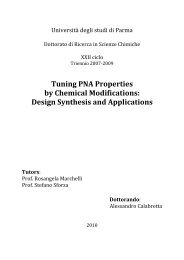Create successful ePaper yourself
Turn your PDF publications into a flip-book with our unique Google optimized e-Paper software.
232 M. Goldoni et al. / Analytica Chimica Acta 562 (2006) 229–235<br />
Fig. 1. Calibration lines of Cr(VI) in the range 0–200 gl −1 in elution buffer<br />
with the extraction of Cr(VI)–DPC in 1-butanol measuring absorbance at 545 nm<br />
(○), and following the NIOSH 7703 protocol measuring absorbance at 540 nm<br />
(). The figure also shows Pearson’s r-value, the intercept and the slope of the<br />
lines with their S.D.s.<br />
(R = 0.999), but the accumulation of Cr–DPC in 1-butanol enormously<br />
enhanced the signal: the slope of the regression lines<br />
passed from 0.60 ± 0.01 for the standard method to 1.83 ± 0.01<br />
for butanol liquid/liquid extraction, and the limit of detection<br />
(LOD) calculated as 3 S.D. of the blank variability changed<br />
from about 1.5 to 0.5 gl −1 . The use of 1-butanol as solvent<br />
shifted the wavelength of maximum absorbance to 545 nm without<br />
changing the intensity of the peak (data not shown).<br />
Fig. 2A shows the experimental detection of Cr(VI) in environmental<br />
samples (20 experimental points in the range of<br />
0.1–7.0 g/membrane) with and without SPE (see Section 2 for<br />
further details). The slope of the straight line in the regression fit<br />
was 1.01 ± 0.03, and the correlation coefficient 0.995 (Fig. 2A),<br />
whereas the Bland–Altman graph (Fig. 2B) showed only one<br />
point between 2 and 3 S.D. (as expected with 20 experimental<br />
points), and the mean deviation between the two methods was<br />
near to 0 (0.03 g/membrane).<br />
In relation to the selected workers, the morning exposure<br />
to total Cr [3.7 (2.8) gm −3 , range 0.8–14.1 gm −3 ] was not<br />
statistically different from the afternoon exposure [4.6 (2.7)<br />
gm −3 , range 1.4–23.4 gm −3 ]. This was confirmed by the<br />
measurements of Cr(VI), which passed from 2.5 (2.8) (range<br />
0.5–10.3) gm −3 in the morning to 3.3 (3.2) (range 1–17.6)<br />
gm −3 in the afternoon. In terms of % Cr(VI) content, 67.8%<br />
(1.1) (range 56.7–76.6%) of the total Cr in the morning, and<br />
70.1% (1.3) (range 43.9–100%) in the afternoon, was in the<br />
form of soluble Cr(VI).<br />
On the basis of these results, the weighted average exposure of<br />
the workers during the work shift was 4.3 (2.6) (range 1.2–18.6)<br />
gm −3 of total Cr, of which 2.9 (2.6) (range 0.8–13.8) gm −3<br />
was soluble Cr(VI). Soluble Cr(VI) accounted for 67.5% (1.1)<br />
(range 49.9–78.3%) of the total.<br />
3.2. Detection of Cr(VI) in EBC<br />
Various experiments were performed to validate the procedure<br />
for EBC Cr(VI) determinations described in Section 2.<br />
Fig. 2. (A) Correlation between the Cr(VI) concentrations determined with and<br />
without SPE in the environmental air samples, also showing the function of the<br />
fit with the values of the intercept with y-axis (y0) and slope. The expected fit is<br />
y = x. (B) Bland–Altman graph in which the “two methods mean” is the average<br />
of the values measured with and without SPE, and “deviation” the difference<br />
between these values. The figure also shows the lines representing ±2 S.D. (—)<br />
and 3 S.D. (...).<br />
• The signals of standard Cr(VI) alone and complexed with<br />
DPC in aqueous solution measured by means of ETAAS were<br />
similar (differences
















